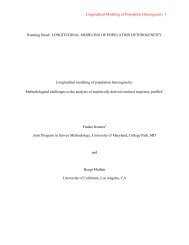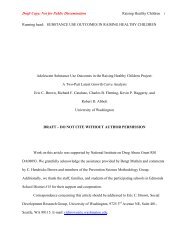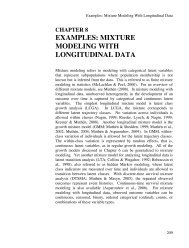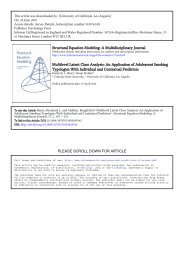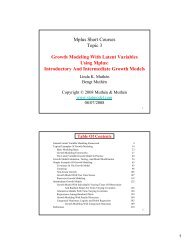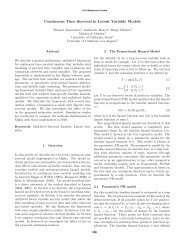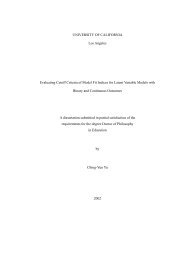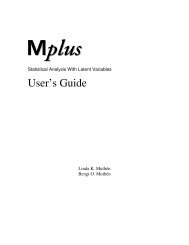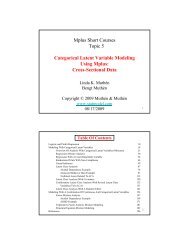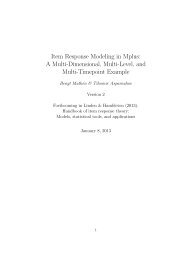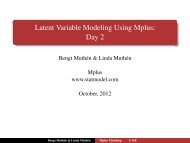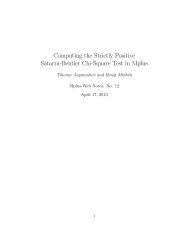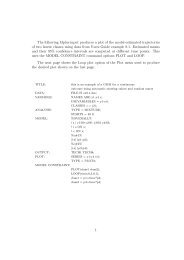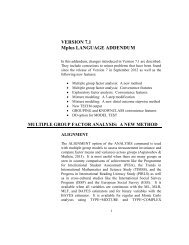Mixture Exploratory Factor Analysis - Mplus
Mixture Exploratory Factor Analysis - Mplus
Mixture Exploratory Factor Analysis - Mplus
You also want an ePaper? Increase the reach of your titles
YUMPU automatically turns print PDFs into web optimized ePapers that Google loves.
Finite <strong>Mixture</strong> EFA in <strong>Mplus</strong><br />
November 16, 2007<br />
In this document we describe the <strong>Mixture</strong> EFA model estimated in <strong>Mplus</strong>.<br />
Four types of dependent variables are possible in this model: normally distributed,<br />
ordered categorical with logit or probit link, Poisson distributed<br />
with the exponential link function, and censored variables. Inflation is not<br />
available for the Censored and Poisson variables.<br />
Suppose that we estimate a K class model with M factors and P dependent<br />
variables. Denote the variables by Y 1 , ..., Y P and the normally distributed<br />
factors by η 1 , ..., η M . Let η be the vector of all latent factors η =<br />
(η 1 , ..., η M ). The <strong>Mixture</strong> model is based on a single categorical latent class<br />
variable C.<br />
For a normally distributed variable Y p we estimate the following model<br />
in class k<br />
Y p = ν kp + λ kp η + ε p<br />
where ν kp is the intercept parameter, λ kp is a vector of loadings of dimension<br />
M, and ε p is a zero mean normally distributed residual with variance θ kp .<br />
For an ordered categorical variable Y p we estimate the following model in<br />
class k<br />
P (Y p = j) = F (τ kpj − λ kp η) − F (τ kpj−1 − λ kp η)<br />
for j = 1, ..., r p where r p is the number of categories that the variable Y p takes.<br />
The parameters τ kpj are monotonically increasing for j and for identification<br />
purposes τ kprp = ∞ and τ kp0 = −∞. The function F is either the standard<br />
normal distribution function, for probit link, or the logit distribution function<br />
F (x) = 1/(1 + Exp(−x)), for logit link. Alternatively we can specify the<br />
model as follows<br />
Y p = j ⇐ τ kpj−1 ≤ Yp<br />
∗ < τ kpj<br />
1
where<br />
Y ∗<br />
p<br />
= λ kp η + ε p<br />
where ε p is a residual with distribution F .<br />
For Poisson distributed variables we estimate the following model in class<br />
k<br />
P (Y p = j) = e −Y (Y ∗<br />
p ∗ p ) j<br />
j!<br />
where<br />
Y ∗<br />
p<br />
= ν kp + λ kp η<br />
and the parameters to be estimated are again the intercept ν kp and the<br />
loading vector λ kp .<br />
For censored variables Y p we estimate the following model in class k<br />
Y p =<br />
{ Y<br />
∗<br />
p<br />
c p<br />
if Yp<br />
∗<br />
if Yp<br />
∗<br />
> c p<br />
≤ c p<br />
where c p is the censoring limit and Y ∗<br />
p<br />
Y ∗<br />
p<br />
is latent normally distributed variable<br />
= ν kp + λ kp η + ε p<br />
where ν kp , λ kp , and the variance θ kp of the zero mean residual ε p are to be<br />
estimated. The above model is for censored variables with a lower end bound.<br />
Similar model is available for censored variables with an upper end bound.<br />
We also estimate an unrestricted correlation matrix Ψ k for the factors η in<br />
class k when we estimate the model with oblique rotation. If we estimate the<br />
model with orthogonal rotation the correlation matrix is fixed to the identity<br />
matrix, i.e., the factors are assumed standard normal and orthogonal in all<br />
classes. Finally we estimate an unrestricted distribution for the latent class<br />
variable C, i.e., we estimate the parameters p k = P (C = k).<br />
The above model is not identified in principle. To be identified the model<br />
has to include an additional M(M − 1) restrictions for oblique rotations or<br />
M(M − 1)/2 restrictions for orthogonal rotations. Before we proceed with a<br />
loading rotation algorithm however we standardize the loadings with respect<br />
to the V ar(Yp ∗ ). For normally distributed Y p we assume that Yp<br />
∗ = Y p . We<br />
construct the standardized loadings λ ∗ kp as follows<br />
λ ∗ kp = λ kp / √ (V ar(Y ∗<br />
p ))<br />
2
where<br />
V ar(Y ∗<br />
p ) = λ kp Ψ p λ T kp + θ kp<br />
where for censored and normal variables θ kp is as specified in the model, for<br />
categorical probit link variable it is θ kp = 1, for categorical logit link variable<br />
θ kp = π 2 /3 and for Poisson variables θ kp = 0. Similarly we standardize the<br />
θ kp parameter<br />
θkp ∗ = θ kp /V ar(Yp ∗ )<br />
Note also that as constructed the standardized loadings are on the correlation<br />
scale, that is, if Λ ∗ k is the matrix of all standardized loadings and Θ ∗ k is the<br />
diagonal matrix with all θkp ∗ on the diagonal, the estimated correlation matrix<br />
of Y ∗ = (Y1 ∗ , ..., YP ∗ ) is<br />
Λ ∗ kΨΛ ∗T<br />
k + Θ ∗ k.<br />
We now define the rotation criteria that will identify the loadings and<br />
the factor correlation Ψ. All oblique factor rotations are defined by a square<br />
matrix H of dimension M such that HH T has ones on the diagonal. All<br />
orthogonal rotations are defined by orthogonal square matrices of dimension<br />
M, i.e., HH T = I, where I is the identity matrix. All such factor rotations<br />
lead to equivalent factor models with M factors. We estimate the rotation<br />
that minimizes the simplicity function, i.e., the rotation criteria<br />
Q(Λ ∗ H)<br />
across all rotation matrices H, where the rotation criteria can be any rotation<br />
criteria such as cf-varimax, quartimin, geomin etc, supported by <strong>Mplus</strong>. With<br />
this additional constraint the loadings and factor correlation are uniquely<br />
defined.<br />
We now focus on the output reported by <strong>Mplus</strong>. For each class the rotation<br />
is performed independently, since all loadings and residual covariances<br />
are class specific. In the <strong>Mplus</strong> output we report the rotated standardized<br />
loadings Λ ∗ H, where H is the optimal rotation. Standard errors for the rotated<br />
standardized loadings are also reported. In addition the class specific<br />
intercepts ν kp are reported, as well as the threshold parameters τ kpj . These<br />
parameters are reported in their original metric, however the threshold parameters<br />
τ kpj are also reported in the standardized correlation metric. Denote<br />
these by τ ∗ kpj. Consequently the estimated probabilities for each category is<br />
computed as follows<br />
P (Y p = j|C = k) = Φ −1 (τ ∗ kpj) − Φ −1 (τ ∗ kpj−1).<br />
3
This computation is exact for the probit link function, however it is only<br />
approximate for the logit link function.<br />
The <strong>Mixture</strong> EFA model estimation can be challenging in some instances.<br />
When all dependent variables are normally distributed there is no numerical<br />
integration involved in the estimation and the computation is fairly quick,<br />
however sufficient number of random starts should be used to ensure that<br />
the global log-likelihood maximum is reached. When some of the variables<br />
are not normally distributed, i.e., Poisson, censored, and ordered categorical<br />
variables, numerical integration is used for all factors and thus the computation<br />
will be significantly slower. With Poisson, censored, and ordered<br />
categorical variables the <strong>Mixture</strong> EFA model is possible but because of the<br />
numerical integration and the random starts perturbation the computational<br />
time might be substantial. <strong>Mixture</strong> EFA with binary variables is a particularly<br />
difficult model to estimate because of the flexibility of the model and<br />
fairly little information provided by binary variables - in particular it is fairly<br />
easy to exceed or approach the maximum degrees of freedom when only a<br />
few binary variables are used. In addition for <strong>Mixture</strong> EFA models with<br />
categorical variables, the best log-likelihood value found in multiple starting<br />
value perturbations, can be difficult to replicate, again due to the flexibility<br />
of the model.<br />
Additional information on mixture factor analysis can be found in McLachlan<br />
and Peel (2000) and McLachlan et al. (2004). <strong>Mixture</strong> factor analysis<br />
with categorical variables is discussed in Muthen and Asparouhov (2006).<br />
<strong>Mixture</strong> EFA analysis is illustrated in Example 4.4, <strong>Mplus</strong> User’s Guide<br />
(Muthen and Muthen, 1998-2007).<br />
References<br />
McLachlan, G. & Peel, D. (2000). Finite mixture models. New York:<br />
John Wiley & Sons.<br />
McLachlan, G.J., Do, K.A., & Ambroise, C. (2004). Analyzing microarray<br />
gene expression data. New York: John Wiley & Sons.<br />
Muthen, B. & Asparouhov, T. (2006). Item response mixture modeling:<br />
Application to tobacco dependence criteria. Addictive Behaviors, 31, 1050-<br />
1066.<br />
4
Muthen, L.K. & Muthen, B.O. (1998-2007). <strong>Mplus</strong> User’s Guide. Fifth<br />
Edition. Los Angeles, CA: Muthen & Muthen<br />
5



